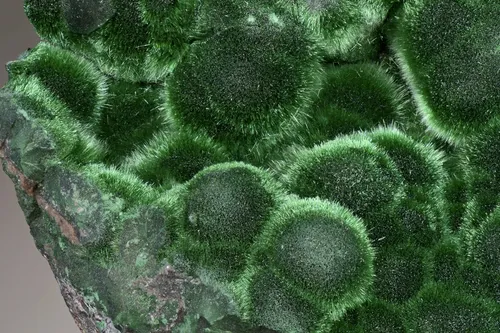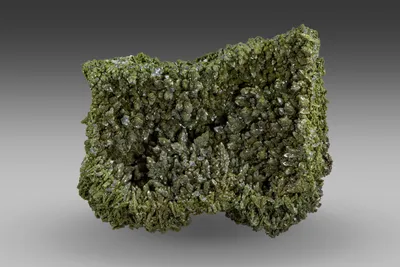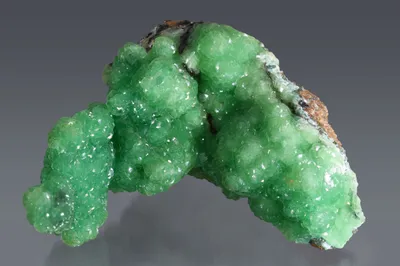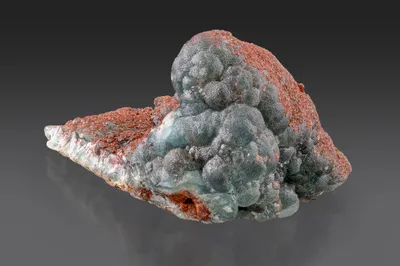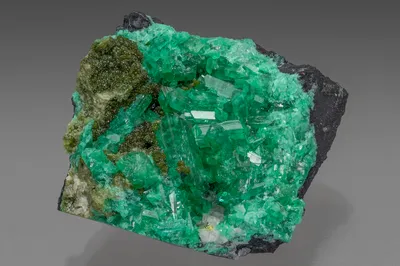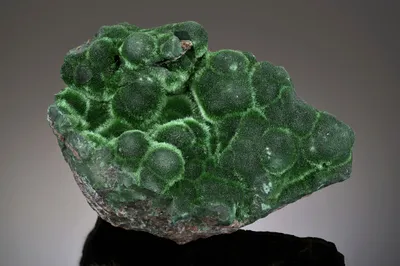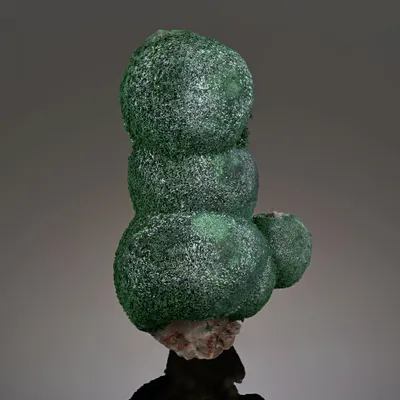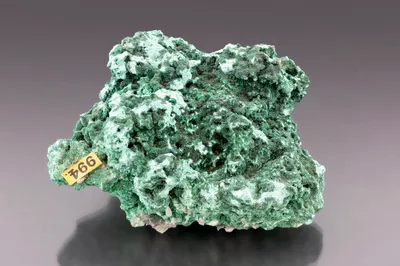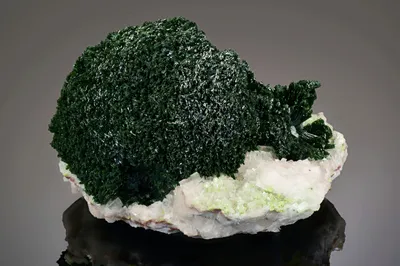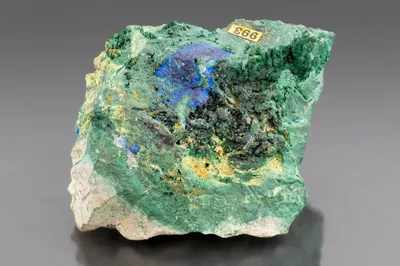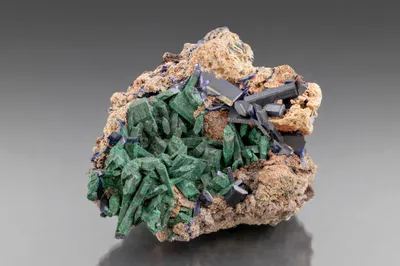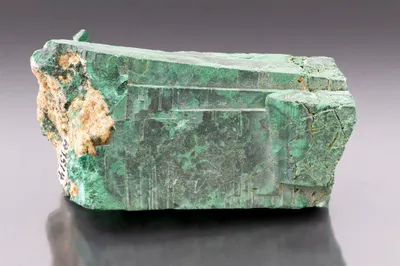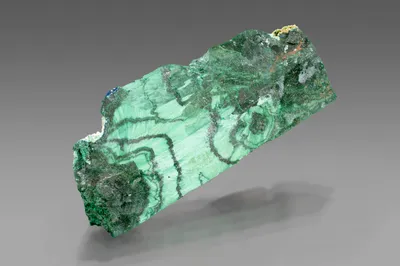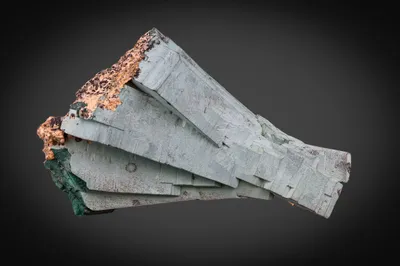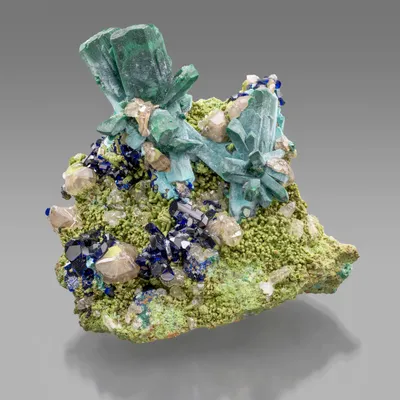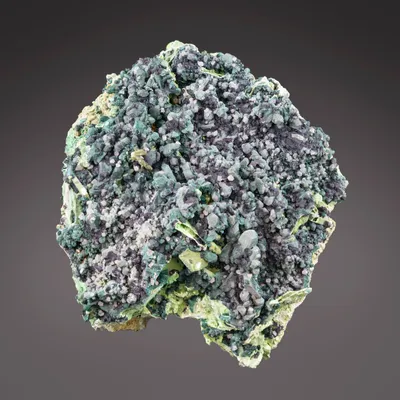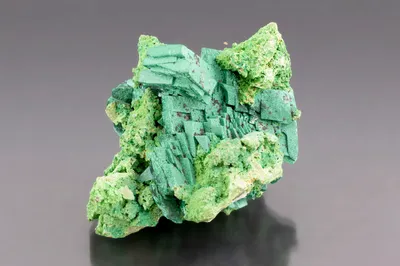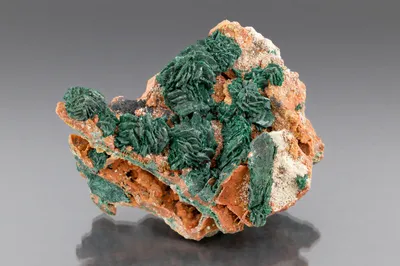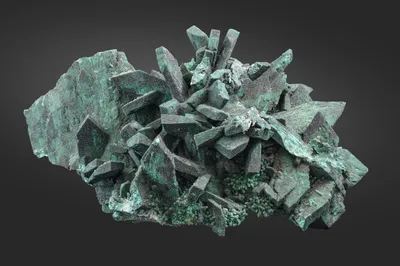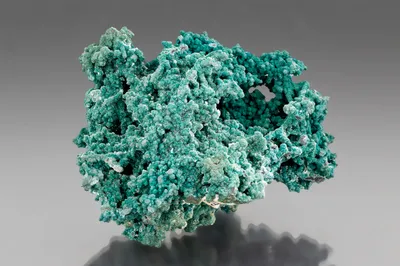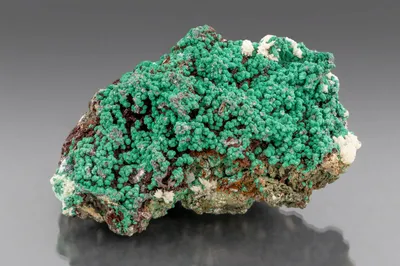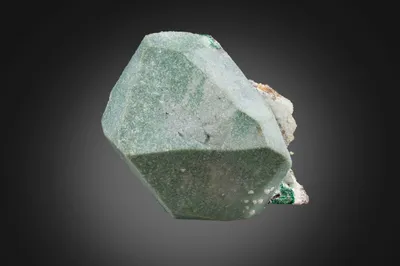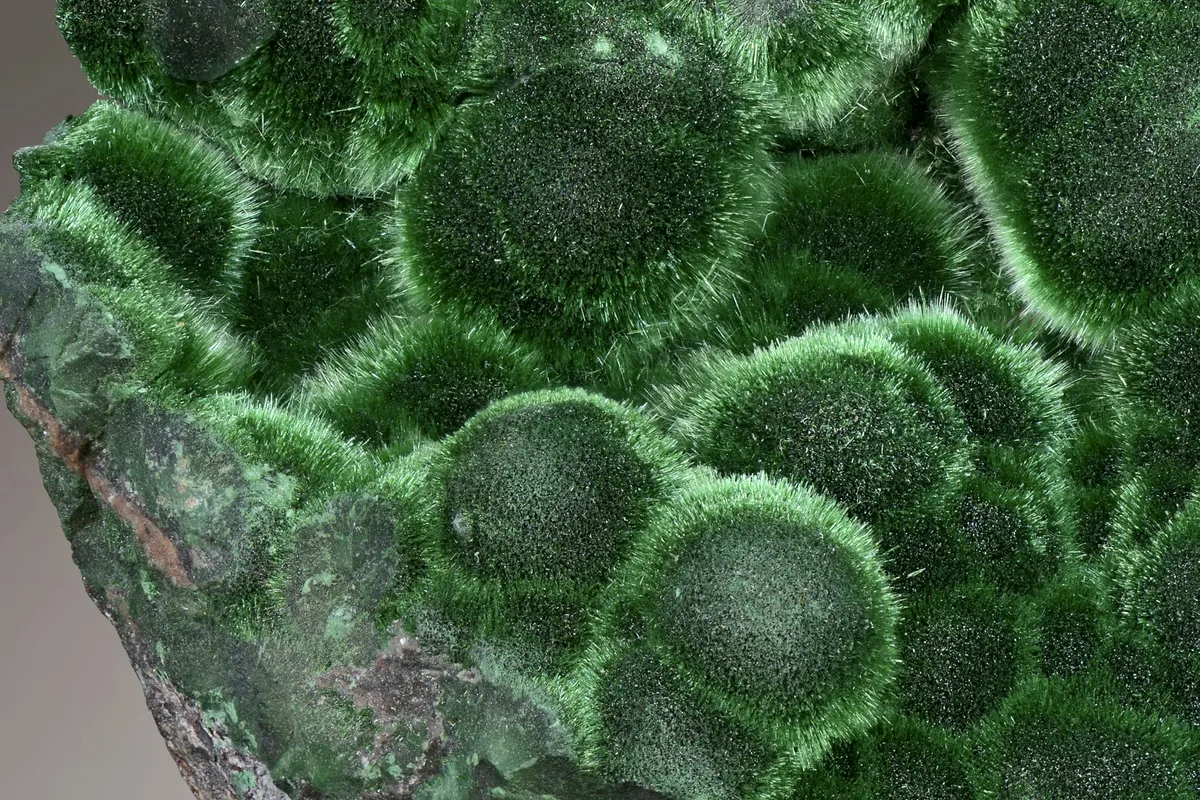
Image Credit: Mariusz Oleszczuk
Mineral Species
Malachite
Type Locality
No
Composition
Cu2(CO3)(OH)2
Crystal System
Orthorhombic
Status at Tsumeb
Confirmed
Abundance
Very common
Distribution
First, second and third oxidation zones
Paragenesis
Supergene
Entry Number
Species; TSNB225
General Notes
Malachite occurs in all three oxidation zones and is by far the most commonly encountered secondary copper mineral at Tsumeb (Bartelke 1976; Keller 1977a). It is particularly abundant in the first oxidation zone.
There are several modes of occurrence:
- Massive, earthy accumulations of malachite, sometimes in complex mixtures with other carbonate minerals (smithsonite, cerussite) and/or arsenates (arsentsumebite, bayldonite, gartrellite etc.). Oxidised ore of this type was of major economic importance, particularly in the upper levels of the mine.
- Pseudomorphs of malachite after azurite, in a wide range of sizes and habits, were found in the first and second oxidation zones (Palache and Lewis 1927; Southwood and Cairncross 2022).
- Aggregates of radiating acicular malachite crystals forming non-pseudomorphous tufts or crusts on copper ores, often with attractive velvety surfaces (Bartelke 1976).
- Large well-formed crystals of non-pseudomorphous malachite are relatively uncommon at Tsumeb, but blocky crystals to 10 mm were found in the first oxidation zone. Similar crystals associated with cuprite were encountered on 43 Level in the third oxidation zone (Gebhard 1999).
- Acicular crystals of malachite (non-pseudomorphous), often forming small spherules or radiating sprays and sometimes relatively inconspicuous, are encountered in a variety of parageneses with a broad range of associated minerals.
Malachite must have been recognised as a component of the "Green Hill" outcrop by the earliest European visitors to Tsumeb, although its first mention in the formal literature is by Schneider (1906) who described "fibrous aggregates" of malachite as well as pseudomorphs after azurite in a variety of habits.
Maucher (1908a) noted the importance of malachite in the secondary (oxidised) ores in the upper levels of the mine, both as a direct product of copper sulphide oxidation and as pseudomorphs after azurite. He also noted the occurrence of intimate mixtures of malachite with lead-copper arsenates.
Klein (1938) observed the presence of malachite from the surface to a depth of 400 m (i.e., throughout the first oxidation zone). He commented that particularly beautiful pseudomorphs of malachite after azurite were found in the upper levels of the Nebentrümer [a side-shoot of the main ore body].
Bartelke (1976) commented that malachite is the most abundant secondary copper mineral at Tsumeb and that traces of it can be found on almost every level of the mine, ranging from the slightest hints of green to thick crusts of radiating malachite needles. These crusts often retain a core of an original copper mineral, sometimes cuprite or native copper and, less commonly, tennantite. Bartelke singled out malachite pseudomorphs after azurite on white dolomite from the first oxidation zone for special mention.
Ruggiero (1977) identified and commented on inclusions of malachite in cerussite crystals.
Keller (1977a) showed that malachite formed at several stages of the oxidation process and is a constituent of several diverse parageneses. It is generally an important component of Keller's (1977) "Type I" parageneses (i.e., mineral sequences formed at higher pH ranges) occurring in four (out of nine) of his proposed Type I sequences:
I/3: cerussite(i) >> mimetite >> (duftite(i) + malachite) >> cerussite(ii) >> duftite(ii)
I/4: goethite >> wulfenite >> mimetite >> malachite
I/7: duftite >> dundasite >> cerussite >> azurite >> malachite (ps. azurite).
I/8: quartz >> mottramite >> olivenite >> duftite >> malachite >> azurite >> malachite (ps. azurite).
Malachite also occurs in the following Type II (i.e., lower pH) sequences:
II/3: primary sulphides >> brochantite >> (posnjakite + malachite) >> linarite >> serpierite.
II/5: primary sulphides >> conichalcite >> adamite >> azurite >> malachite
Keller (1984) made the interesting observation that, of the common secondary minerals at Tsumeb, smithsonite is rarely associated with malachite. He also noted that exceptional crystals of malachite (to 30 mm) have been recorded but did not indicate from which part of the mine.
Malachite is named as an associated mineral on the type specimens for duftite (Pufahl 1920) and otavite (Schneider 1906).
The famous azurite monograph of Palache and Lewis (1927) included a detailed account of the replacement of azurite by malachite, a theme later revisited by Southwood and Cairncross (2022) and by Straw (2023). Palache and Lewis (1927) studied numerous examples of malachite replacing azurite from Tsumeb. They noted that pseudomorphs of malachite after azurite are commonly ensheathed by a layer (or partial layer) of secondary azurite. Southwood and Cairncross (2022) argued that, in many cases, the outer sheath of azurite is in fact relict primary azurite and that, somewhat counter-intuitively, the alteration has progressed outwards from the core of the crystal.
Pseudomorphs of malachite after azurite were most abundant (by far) in the first oxidation zone. However, a major discovery was made in 1980 in the second oxidation zone, well-known to collectors as the "Perkins Sams Pocket" (Southwood and Cairncross 2022; Southwood 2022d). The pseudomorphs from this discovery reach up to 20 cm across and are almost completely malachite, with just a thin partial veneer of relict azurite providing an attractive electric-blue colour contrast. The location of this discovery was never officially published but is believed to be the North-West Stope, No. 2 sub-level, 35 Level (Ludger Krahn, pers. comm to M Southwood, 2015).
Associated Minerals
agardite-(Ce); anglesite; aragonite; arsenogoyazite; arsentsumebite; azurite; bayldonite; beaverite-(Cu); berzelianite (?); beudantite; bornite; brochantite; calcite; caledonite; cerussite; chalcocite; chalcophyllite (?); chenevixite; clinoclase; conichalcite; copper; cornwallite; covellite; cuprite; devilline; dioptase; dolomite; duftite; dundasite; enargite; eugenite; gartrellite; goethite; goudeyite (?); gypsum; hidalgoite; hydrocerussite; linarite; ludlockite; mimetite; minrecordite; mottramite; olivenite; otavite; philipsbornite; phosphohedyphane (?); plancheite; posnjakite; quartz; rosasite; serpierite; shattuckite (?); silver; smithsonite; tennantite-(Zn); tsumebite; willemite; wulfenite; zincolivenite
Pseudomorphs
Malachite has been reported to form pseudomorphs after the following minerals: aragonite (rare); azurite (abundant); copper (common); cuprite (common); enargite (rare); tennantite (rare); wulfenite (rare).
The following minerals have been reported to form pseudomorphs after malachite: rosasite (common, the so-called "double pseudomorph", with the malachite itself already pseudomorphous after azurite).
